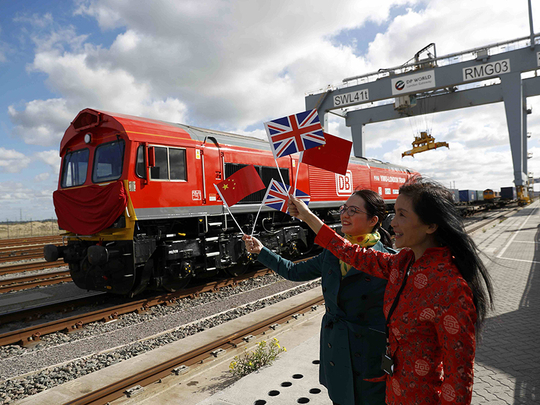
London: After the last three containers were lifted onto the wagons, the driver gave a thumbs-up and tooted his horn as he got the train rolling at the port in Stanford-le-Hope, east of London.
The train’s destination is 12,070km away, in the Chinese city of Yiwu, near Shanghai. It is first time a train has made the run from London to China, but it is also a return trip. In January the first freight train from China to the UK rolled into London, carrying clothes, shoes, suitcases and other goods made in China. The trip will take 18 days. The train, hauling 32-containers and measuring over 600-metres long, will go through the Channel Tunnel before travelling across France, Belgium, Germany, Poland, Belarus, Russia and Kazakhstan before heading into China.
This new route is part of China’s “One Belt, One Road” programme announced in 2013, reviving the ancient Silk Road trading routes to Europe.
The rail route is cheaper than air freight and faster than sea freight. While Ultra-Large Cargo Carriers like MOL Triumph, the world’s largest shipping vessel, can carry 20,000 containers on a single voyage, it takes 28 to 30 days to make the trip from London to central China. The new route also offers logistics companies a new middle option. Some of the containers, which contain vitamins and pharmaceutical products, will be taken off and put on different wagons as they leave Poland, as the former Soviet Union countries use a wider rail gauge.
“Restoring the ancient Silk Road as a means by which China, north Europe and now the UK can exchange goods is an important and exciting initiative,” said Xubin Feng, the chairman of Yiwu Timex Industrial Investment, which is co-running the service. “We have great faith in the UK as an export nation and rail provides an excellent alternative for moving large volumes of goods over long distances faster.”
DP World Chief Executive Sultan Ahmad Bin Sulayem, whose company runs the port where the trains began its journey, said the first freight service from Britain to China is a “significant trade occasion”.
“We look forward to enabling and facilitating more trade between Britain, China and the whole world,” he said, adding that the London Gateway port is designed and developed to ensure products can be both imported and exported from the UK via ship or train in a faster, safer and more reliable way than ever before.
Boosting trade with China is a top priority for Britain as it leaves the EU and becomes free to strike its own trade deals.
London was hailing the first export train as part of its “global Britain” plan, recalibrating its post-EU trading outlook.
Rupert Soames, Prime Minister Theresa May’s business ambassador for infrastructure and transport, told AFP that the new route was “positive and timely”.
“I genuinely think that this is quite a historic day,” said Soames, a grandson of World War II prime minister Winston Churchill.
“In some quarters now, globalisation is seen as a bad word. But here you see trade in all its glory and possibilities.”
China was Britain’s seventh-biggest export market last year, behind the United States, Germany, France, the Netherlands, Ireland and Switzerland.
Some £13.5 billion of trade headed to China, according to UK government statistics, with an average annual growth rate of 12.9 per cent since 2006.
In terms of imports, China is Britain’s third-biggest market after Germany and the United States, with trade worth £35.8 billion last year.












